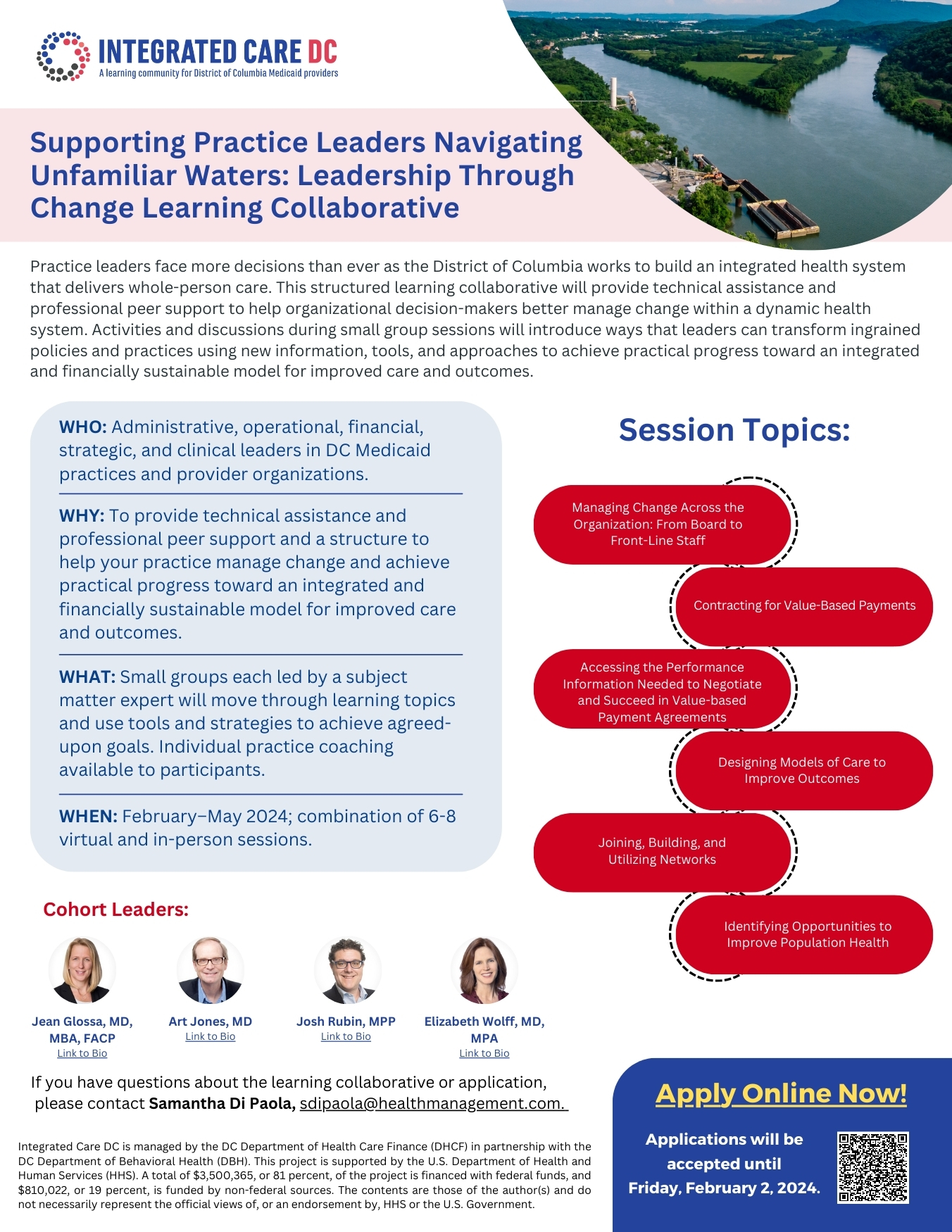Description: Practice leaders face more decisions than ever as the District of Columbia works to build an integrated health system that delivers whole-person care. This structured learning collaborative will provide technical assistance and professional peer support to help organizational decision-makers better manage change within a dynamic health system. Activities and discussions during small group sessions will introduce ways that leaders can transform ingrained policies and practices using new information, tools, and approaches to achieve practical progress toward an integrated and financially sustainable model for improved care and outcomes.
Participants will be assigned to small cohorts that will meet 6–8 times over a four-month period in both Zoom and in-person sessions. Applicants will be asked to commit to active participation in all sessions and to complete assignments between group meetings. Participants will receive group and individual technical assistance from subject matter experts and will have opportunities to learn and share with each other.

Download the Learning Collaborative Flyer PDF.
Save the Date: There will be an in-person session on February 21st.
Speakers: Jean Glossa, MD, MBA, FACP, Managing Director, Health Management Associates, Art Jones, MD, Principal, Health Management Associates, Elizabeth Wolff, MD, MPA, Principal, Health Management Associates, & Josh Rubin, MPP, Principal, Health Management Associates




Content Level: Moderate
Target Audience: Administrators & Clinicians
Course Interaction & System Requirements: This live webinar is fully interactive. Attendees may ask and answer questions throughout the presentation and participate in instructor-led discussions.
System Requirements:
- Operating Systems: Windows XP or higher, MacOS 9 or higher, Android 4.0 or higher
- Internet Browser: Internet Explorer 9.0 or higher, Google Chrome, Firefox 10.0 or higher
- Broadband Internet connection: Cable, high-speed DSL & any other medium that is internet accessible
Learning Collaborative Sessions:
Topic 1: Introduction/Overview
Description: This session provides an overview of the leadership series, its structure, and goals. Cohort leaders will provide examples of the specific topics to be covered throughout the series and elicit from participants key areas where they are challenged in advancing value-based care. The session will also introduce the value-based readiness assessment, so participants can begin individualized work on this tool that may carry through subsequent sessions.
Learning Objectives:
- Explain the purpose and processes of the leadership learning collaborative
- Describe three key topics that will be discussed in the learning collaborative
- Identify key challenges the organization is having in advancing value-based care
Tool/Milestone:
- VBP readiness assessment
Topic 2: Managing Change Across the Organization: From Board to Front-Line Staff
Description: Change management requires both technical and adaptive leadership skills. Technical leadership encompasses subject matter expertise where a solution is clear. Adaptive leadership drives change by addressing resistance and changing attitudes and behaviors. This session will describe these forms of leadership and discuss factors necessary for adaptive leadership, including a communications plan.
Learning Objectives:
- Contrast technical versus adaptive leadership
- Describe key factors necessary for successful adaptive leadership
- Outline the components of a communication plan
Tool/Milestone:
- Pre-session: DiSC® leadership assessment
- Post-session: Communications plan template
Topic 3: Contracting for Value-Based Payments
Description: Successful contracting for value-based payments (VBP) requires understanding related term definitions and the types of alternative payment methodologies (APMs) being offered in the market by the payers for each provider type. Providers should also understand how the practice would have performed under those APMs historically if contracted for them; the probability of improving performance enough to succeed under those APMs, and the resources and commitment needed to achieve that success; and risk appetite. This session(s) will provide key definitions and discuss strategies for negotiating favorable terms by APM type.
Learning Objectives:
- Understand a glossary of key terms used in value-based payment contracts
- Describe the different types of value-based contracts and identify which are most appropriate for your organization to pursue
- Understand the strategic and operational implications of different types of value-based contracts
- Understand the importance of analyzing clinical data in preparation for value-based contracting
Tool/Milestone:
- Pre-session: Read the VBP glossary and come prepared with a list of terms that you do not understand.
- Post-session: Create a draft contracting strategy specific to your organization
Topic 4: Accessing the Performance Information Needed to Negotiate and Succeed in Value-based Payment Agreements
Description: Value-based payment (VBP) agreements typically incent the provider to improve assigned or attributed member outcomes on quality and sometimes member experience, health service utilization, and/or cost metrics. Providers need timely and actionable access to baseline and ongoing performance information to drive, document, and demonstrate improvement. Some of the needed information may be accessible through provider electronic medical records, the CRISP DC health information exchange, or health plans’ provider portals and reports. The information must not only allow assessment of overall performance but also allow drilling down to identify individual members of the target population who have not reached specified targets or who have gaps in care.
Learning Objectives:
- Differentiate between active patients versus attributed members in VBP agreements
- Understand which data sources are timely and can inform action versus the final source of truth used to determine VBP-related outcomes
- Create a list of payer-generated reports needed to negotiate a VBP agreement with reasonable prospect for success and to monitor progress in meeting performance goals
Tool/Milestone:
- Pre-session: Create an inventory of your organization’s ability to generate or access performance reports on the quality, utilization and cost metrics commonly found in VBP contracts for your provider type
- Post-session: Populate that report with your historical performance for at least one payer
Topic 5: Designing Models of Care to Improve Outcomes
Description: Value-based contracting allows for innovative care models that incorporate all team members and allow them to work at the top of their license. This session will describe care management and care teams models with a particular emphasis on the collaborative care model and interprofessional consultations (eConsults), which are reimbursable under DC Medicaid. These new models of care have potential for significant impact on quality and access to care, but they require organizations to implement new workflows and processes.
Learning Objectives:
- Describe the importance of care management in managing chronic diseases
- Contrast the roles of care coordinators and care managers
- List examples of care team role optimization in improving consultations and referrals (e.g., eConsult)
- Explain the collaborative care model and how it is billed and reimbursed
Tool/Milestone:
- Billing guide for collaborative care
- Draft policy and procedure for collaborative care and/or interprofessional consultations
Topic 6: Joining, Building, and Utilizing Networks
Description: Integrated models of care and alternative payment methodologies require providers to offer a comprehensive package of services, access and utilize significant infrastructure, manage risk across a broad population, and generate negotiating leverage. Few, if any, provider organizations will be able to achieve these essential and diverse capabilities on their own. As a result, network membership decisions (which, in what capacity, when, build/buy, how to maximize) will be existential strategic drivers for many organizations.
Learning Objectives:
- Understand the trends driving the need for network participation, and their clinical, pragmatic, financial, and operational implications
- Understand the differences between different types of networks (IPAs, ACOs, CINs, MSOs, etc.)
- Understand the strategic drivers of network participation decisions (who to join, when to join, how to join, how to utilize) and their implications
Tool/Milestone:
- Pre-session: Network need screening tool
- Post-session: Network strategy assessment tool
Topic 7: Identifying Opportunities to Improve Population Health
Description: To succeed in value-based payment (VBP) arrangements, providers must be able to identify what they can do differently to improve performance on metrics with financial implications and prioritize those efforts by resource demands, dependence on external partners, and probability for success with a return-on-investment projection. Identifying opportunities for improvement with targeted populations often requires conversations with payers that can generate reports from a larger but similar population.
Learning Objectives:
- Identify potential opportunities to improve quality, health service utilization, and/or cost metrics for the targeted population you serve
- Create a list of reports that would help to identify interventions to act upon those opportunities and the information source for each
- Develop a strategy to access that data source and begin to analyze it
- Prioritize the list of improvement opportunities to inform contract negotiations
Tool/Milestone:
- Pre-session: Create a preliminary list of potential opportunities to improve quality, health service utilization, and/or cost metrics for the targeted population you serve.
- Post-session: Prioritize the list of improvement opportunities to inform contract negotiations.
